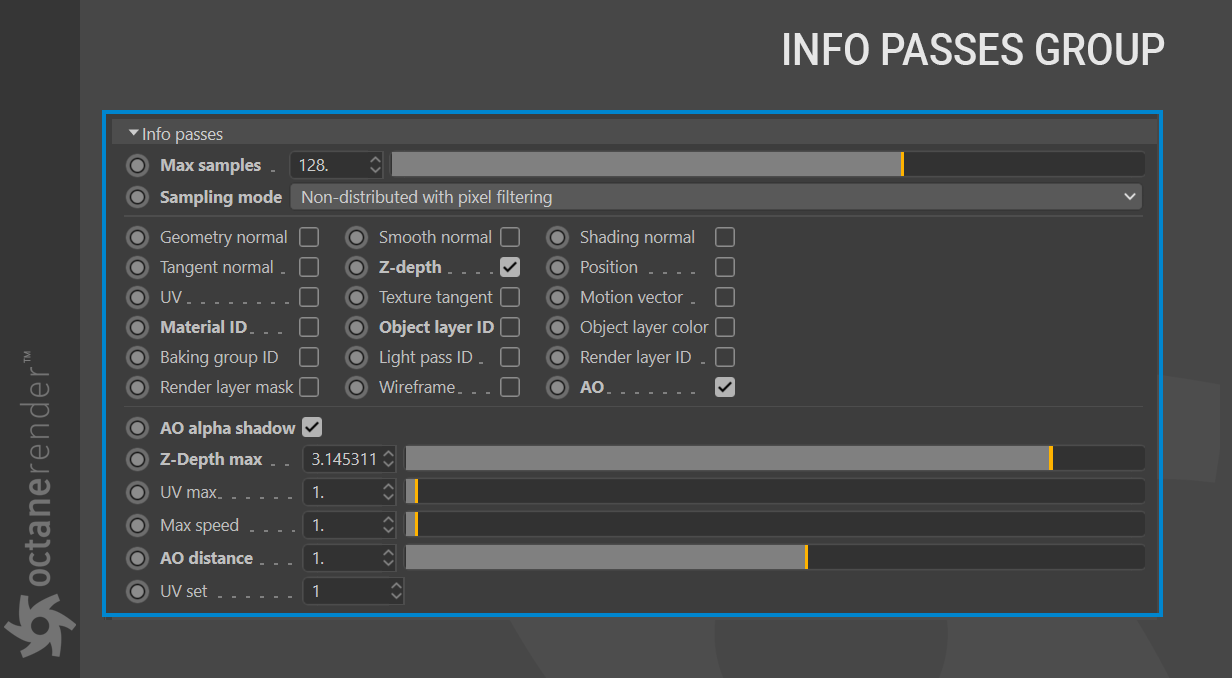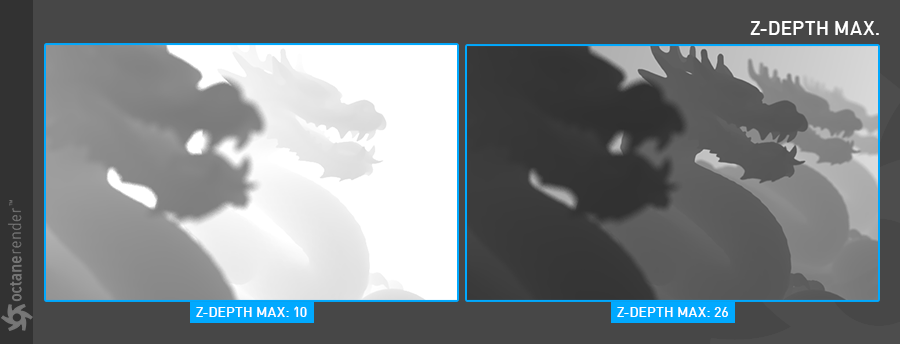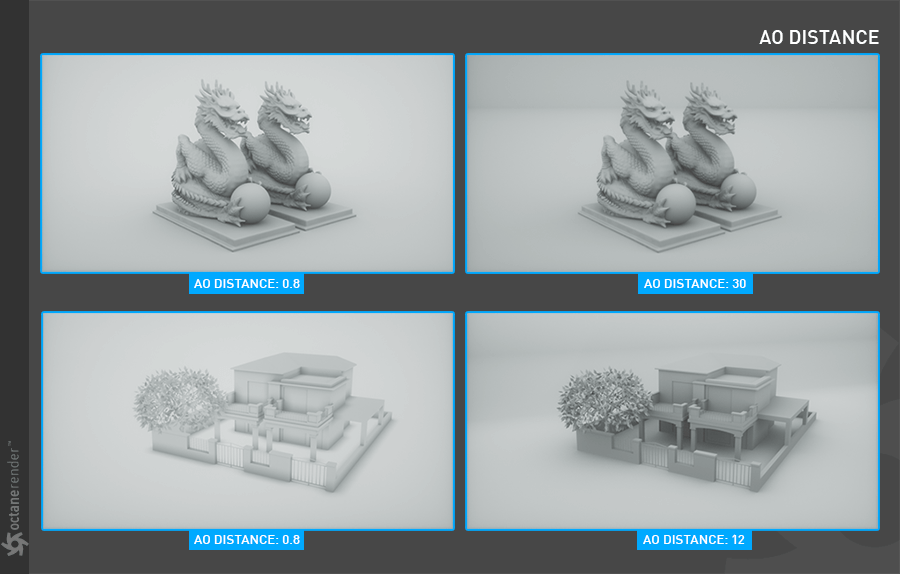Info Passes
Info Passes and Info Passes AOVs are render passes that provide a view of the effects of normals, UVs and other geometric data within the scene. Many options here can help be of assistance when compositing. When any of these passes are enabled, they can be previewed in the Live Viewer, via the pass tabs that will appear at the bottom of the Live Viewer frame.

MAX. SAMPLES:
Sets the maximum number of samples per pixel only for the info channels. This parameter is independent from the “max samples” in the Kernel Settings.
SAMPLING MODE:
This option has three sub-menus:
Distributed Rays:
Option to show distributed ray tracing, i.e., if enabled, motion blur and DOF are sampled. This is enabled by default.
Non-Distributed with Pixel Filtering:
Removes any DOF or Motion Blur from the selected info channel using Pixel filtering. This will produce a smoothed image.
Non-Distributed without Pixel Filtering:
Removes any DOF or Motion Blur from the selected info channel without Pixel filtering. Jagged edges may appear in the picture.
RENDER PASS OUTPUT
The following passes are viewable in the Live Viewer by selecting a given channel selection. These passes are typically false colored at 24 bits per component unless otherwise noted:
Geometry Normal
Assigns a color for the geometry normal at the position hit by the camera ray.
Tangent Normal
Assigns a color to the Tangent (local) normal at the position hit by the camera ray.
UV
Assigns RGB values according to the geometry’s texture coordinates.
Material ID
Assigns RGB values according to the materials mapped to the geometry.
Baking Group ID
Colors each distinct baking group in the scene with a color based on its ID.
Render Layer Mask
Mask for the geometry on the active Render Layer.
Smooth Normal
Assigns a color for the smooth normal at the position hit by the camera ray.
Z-Depth
Assigns a gray value proportional to the camera ray hit distance. Image planes closest to camera position will appear black, and the furthest will appear white. Depth maps should always be saved in a 32-bit image format for maximum precision. When this image pass is rendered in the Picture Viewer, it will appear to be completely white, but the depth information is still there. Use the Filter controls in the Picture Viewer for verification. Set the controls in the compositing application of choice to create the desired depth range for the composition.
| NOTE When exporting a depth pass with the EXR(Octane) format, two Z depth layers will be saved: Z-depth.Y and Z-depth.A. For compositing purposes, use the Z-depth.Y layer, as it contains the actual depth information for the scene. The Z-depth.A layer contains opacity information for the depth pass. |
|---|
Texture Tangent
The tangent vector of U texture coordinates (Dp, Du).
Object Layer ID
Colors each distinct object in the scene with a color based on its ID.
Light Pass ID
Colors the emitters based on their Light Pass ID.
Wireframe
Triangulated wireframe display of the geometry.
Shading Normal
Assigns a color for the shading normal at the position hit by the camera ray.
Position
Assigns RGB values according to the intersection point of the camera ray.
Motion Vector
Renders the motion vectors as 2D vectors in screen space. The X coordinate (stored in the red channel) is motion to the right, in pixels. The Y coordinate (stored in the green channel) is the motion up, in pixels. When this pass is enabled, the rendering of motion blur is disabled.
Object Layer Color
This is the color specified in the Object Layer node.
Render Layer ID
Colors objects on the same layer with the same color based on the Render Layer ID.
AO (Ambient Occlusion)
Assigns a color to the camera ray’s hit point proportional to the amount of occlusion by other geometry.
AO ALPHA SHADOW
Takes the surface opacity as determined by its shader into account when rendering with the Ambient Occlusion info channel. Enable this option if the AO pass results are not what is expected.
Z-DEPTH MAX:
Determines the maximum depth of Z-depth info channel type as shown in the image below and applies only to tone-mapped outputs. In the case of 32-bit render output, the max value will be the extents of the scene, in scene units. This option is available when “Z-depth” option is selected in Render Passes.

UV MAX:
This option is available when “UV” type is selected. Sets the maximum value that can be shown for the texture UV coordinates.

MAX SPEED:
This option is available when “Motion Vector” type is selected. Speed is mapped to the maximum intensity in the motion vector channel. A value of 1 means a maximum movement of 1 screen width in the shutter interval.
AO DISTANCE:
This option controls the distance of the ambient occlusion shadowing spread. This setting should be adjusted in order to achieve realistic results depending on the scale of the objects in the scene. For example, a small value is more appropriate for small objects such as toys and larger values for an object such as a house. Enable AO Alpha Shadow with this option, otherwise the result will contain additional information.

UV SET:
Specifies the set of UV coordinates to use.
RENDER OUT PROPER Z-DEPTH PASS
The following two diagrams show both the Linear and Tone mapped workflow for Z-Depth Pass output. In fact, these 2 diagrams are valid for all passes, not only for Z-Depth.



